Identifying Clinical Priorities and Multidisciplinary Support for Mrs Mabel Winter
VerifiedAdded on 2023/01/18
|16
|4677
|43
AI Summary
This essay aims to identify three clinical priorities of Mrs Mabel Winter, an 89-year old widowed lady, and the multidisciplinary team members and resources that will be important to avoid future hospitalization.
Contribute Materials
Your contribution can guide someone’s learning journey. Share your
documents today.

Running head: NURS 3003
NURS 3003 – Dynamics of Practice 3
Name of the Student
Name of the University
Author Note
NURS 3003 – Dynamics of Practice 3
Name of the Student
Name of the University
Author Note
Secure Best Marks with AI Grader
Need help grading? Try our AI Grader for instant feedback on your assignments.
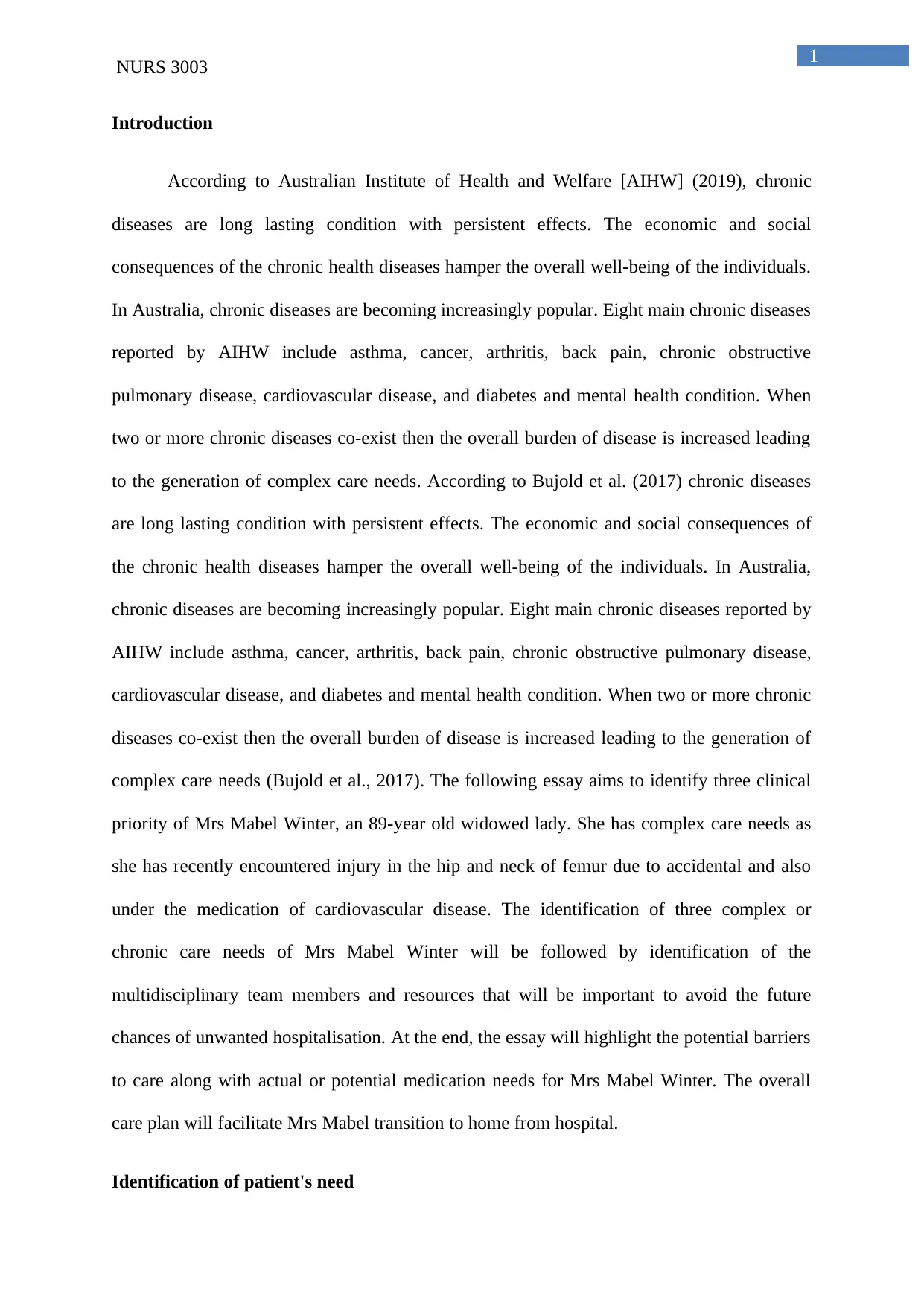
1
NURS 3003
Introduction
According to Australian Institute of Health and Welfare [AIHW] (2019), chronic
diseases are long lasting condition with persistent effects. The economic and social
consequences of the chronic health diseases hamper the overall well-being of the individuals.
In Australia, chronic diseases are becoming increasingly popular. Eight main chronic diseases
reported by AIHW include asthma, cancer, arthritis, back pain, chronic obstructive
pulmonary disease, cardiovascular disease, and diabetes and mental health condition. When
two or more chronic diseases co-exist then the overall burden of disease is increased leading
to the generation of complex care needs. According to Bujold et al. (2017) chronic diseases
are long lasting condition with persistent effects. The economic and social consequences of
the chronic health diseases hamper the overall well-being of the individuals. In Australia,
chronic diseases are becoming increasingly popular. Eight main chronic diseases reported by
AIHW include asthma, cancer, arthritis, back pain, chronic obstructive pulmonary disease,
cardiovascular disease, and diabetes and mental health condition. When two or more chronic
diseases co-exist then the overall burden of disease is increased leading to the generation of
complex care needs (Bujold et al., 2017). The following essay aims to identify three clinical
priority of Mrs Mabel Winter, an 89-year old widowed lady. She has complex care needs as
she has recently encountered injury in the hip and neck of femur due to accidental and also
under the medication of cardiovascular disease. The identification of three complex or
chronic care needs of Mrs Mabel Winter will be followed by identification of the
multidisciplinary team members and resources that will be important to avoid the future
chances of unwanted hospitalisation. At the end, the essay will highlight the potential barriers
to care along with actual or potential medication needs for Mrs Mabel Winter. The overall
care plan will facilitate Mrs Mabel transition to home from hospital.
Identification of patient's need
NURS 3003
Introduction
According to Australian Institute of Health and Welfare [AIHW] (2019), chronic
diseases are long lasting condition with persistent effects. The economic and social
consequences of the chronic health diseases hamper the overall well-being of the individuals.
In Australia, chronic diseases are becoming increasingly popular. Eight main chronic diseases
reported by AIHW include asthma, cancer, arthritis, back pain, chronic obstructive
pulmonary disease, cardiovascular disease, and diabetes and mental health condition. When
two or more chronic diseases co-exist then the overall burden of disease is increased leading
to the generation of complex care needs. According to Bujold et al. (2017) chronic diseases
are long lasting condition with persistent effects. The economic and social consequences of
the chronic health diseases hamper the overall well-being of the individuals. In Australia,
chronic diseases are becoming increasingly popular. Eight main chronic diseases reported by
AIHW include asthma, cancer, arthritis, back pain, chronic obstructive pulmonary disease,
cardiovascular disease, and diabetes and mental health condition. When two or more chronic
diseases co-exist then the overall burden of disease is increased leading to the generation of
complex care needs (Bujold et al., 2017). The following essay aims to identify three clinical
priority of Mrs Mabel Winter, an 89-year old widowed lady. She has complex care needs as
she has recently encountered injury in the hip and neck of femur due to accidental and also
under the medication of cardiovascular disease. The identification of three complex or
chronic care needs of Mrs Mabel Winter will be followed by identification of the
multidisciplinary team members and resources that will be important to avoid the future
chances of unwanted hospitalisation. At the end, the essay will highlight the potential barriers
to care along with actual or potential medication needs for Mrs Mabel Winter. The overall
care plan will facilitate Mrs Mabel transition to home from hospital.
Identification of patient's need
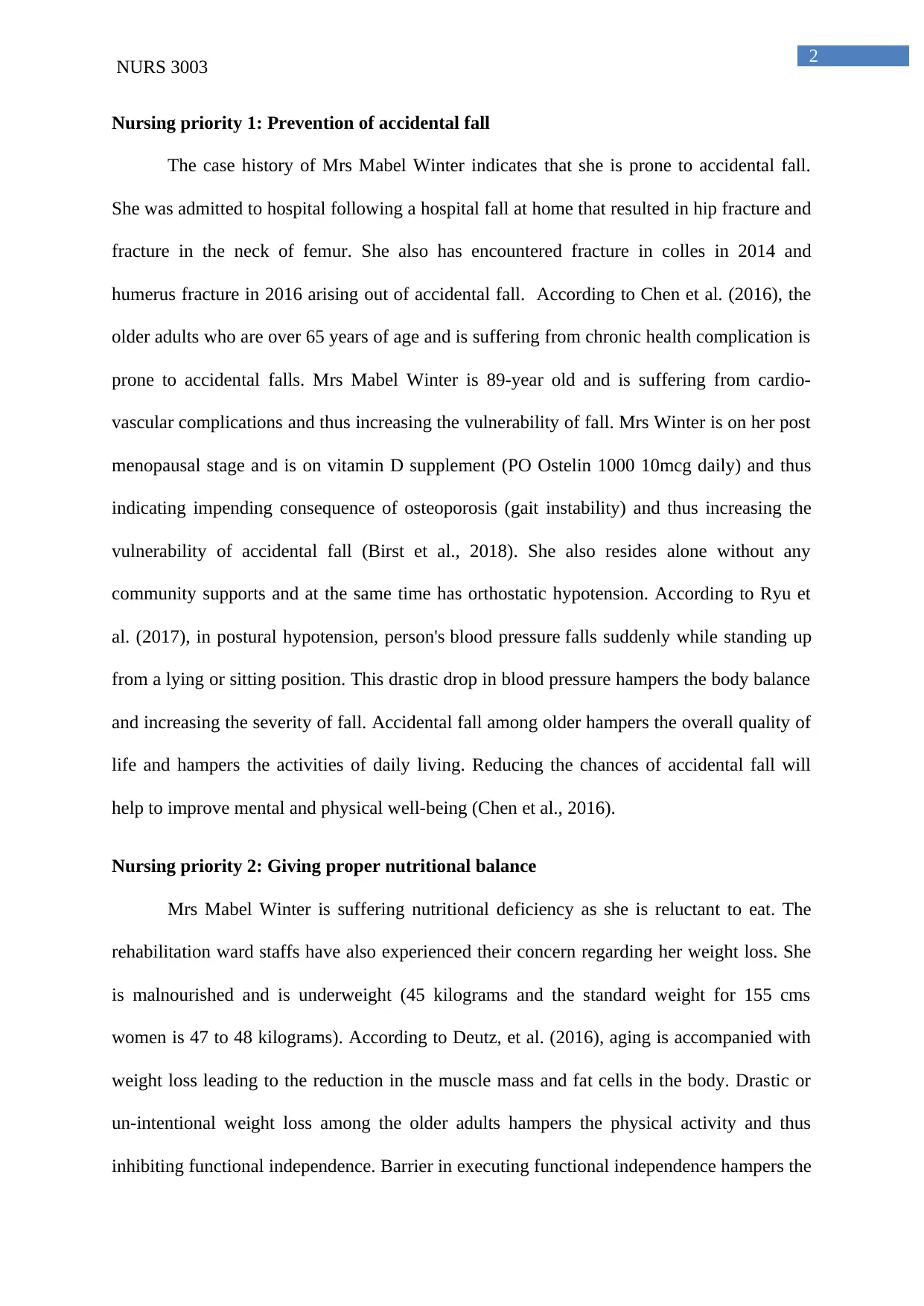
2
NURS 3003
Nursing priority 1: Prevention of accidental fall
The case history of Mrs Mabel Winter indicates that she is prone to accidental fall.
She was admitted to hospital following a hospital fall at home that resulted in hip fracture and
fracture in the neck of femur. She also has encountered fracture in colles in 2014 and
humerus fracture in 2016 arising out of accidental fall. According to Chen et al. (2016), the
older adults who are over 65 years of age and is suffering from chronic health complication is
prone to accidental falls. Mrs Mabel Winter is 89-year old and is suffering from cardio-
vascular complications and thus increasing the vulnerability of fall. Mrs Winter is on her post
menopausal stage and is on vitamin D supplement (PO Ostelin 1000 10mcg daily) and thus
indicating impending consequence of osteoporosis (gait instability) and thus increasing the
vulnerability of accidental fall (Birst et al., 2018). She also resides alone without any
community supports and at the same time has orthostatic hypotension. According to Ryu et
al. (2017), in postural hypotension, person's blood pressure falls suddenly while standing up
from a lying or sitting position. This drastic drop in blood pressure hampers the body balance
and increasing the severity of fall. Accidental fall among older hampers the overall quality of
life and hampers the activities of daily living. Reducing the chances of accidental fall will
help to improve mental and physical well-being (Chen et al., 2016).
Nursing priority 2: Giving proper nutritional balance
Mrs Mabel Winter is suffering nutritional deficiency as she is reluctant to eat. The
rehabilitation ward staffs have also experienced their concern regarding her weight loss. She
is malnourished and is underweight (45 kilograms and the standard weight for 155 cms
women is 47 to 48 kilograms). According to Deutz, et al. (2016), aging is accompanied with
weight loss leading to the reduction in the muscle mass and fat cells in the body. Drastic or
un-intentional weight loss among the older adults hampers the physical activity and thus
inhibiting functional independence. Barrier in executing functional independence hampers the
NURS 3003
Nursing priority 1: Prevention of accidental fall
The case history of Mrs Mabel Winter indicates that she is prone to accidental fall.
She was admitted to hospital following a hospital fall at home that resulted in hip fracture and
fracture in the neck of femur. She also has encountered fracture in colles in 2014 and
humerus fracture in 2016 arising out of accidental fall. According to Chen et al. (2016), the
older adults who are over 65 years of age and is suffering from chronic health complication is
prone to accidental falls. Mrs Mabel Winter is 89-year old and is suffering from cardio-
vascular complications and thus increasing the vulnerability of fall. Mrs Winter is on her post
menopausal stage and is on vitamin D supplement (PO Ostelin 1000 10mcg daily) and thus
indicating impending consequence of osteoporosis (gait instability) and thus increasing the
vulnerability of accidental fall (Birst et al., 2018). She also resides alone without any
community supports and at the same time has orthostatic hypotension. According to Ryu et
al. (2017), in postural hypotension, person's blood pressure falls suddenly while standing up
from a lying or sitting position. This drastic drop in blood pressure hampers the body balance
and increasing the severity of fall. Accidental fall among older hampers the overall quality of
life and hampers the activities of daily living. Reducing the chances of accidental fall will
help to improve mental and physical well-being (Chen et al., 2016).
Nursing priority 2: Giving proper nutritional balance
Mrs Mabel Winter is suffering nutritional deficiency as she is reluctant to eat. The
rehabilitation ward staffs have also experienced their concern regarding her weight loss. She
is malnourished and is underweight (45 kilograms and the standard weight for 155 cms
women is 47 to 48 kilograms). According to Deutz, et al. (2016), aging is accompanied with
weight loss leading to the reduction in the muscle mass and fat cells in the body. Drastic or
un-intentional weight loss among the older adults hampers the physical activity and thus
inhibiting functional independence. Barrier in executing functional independence hampers the
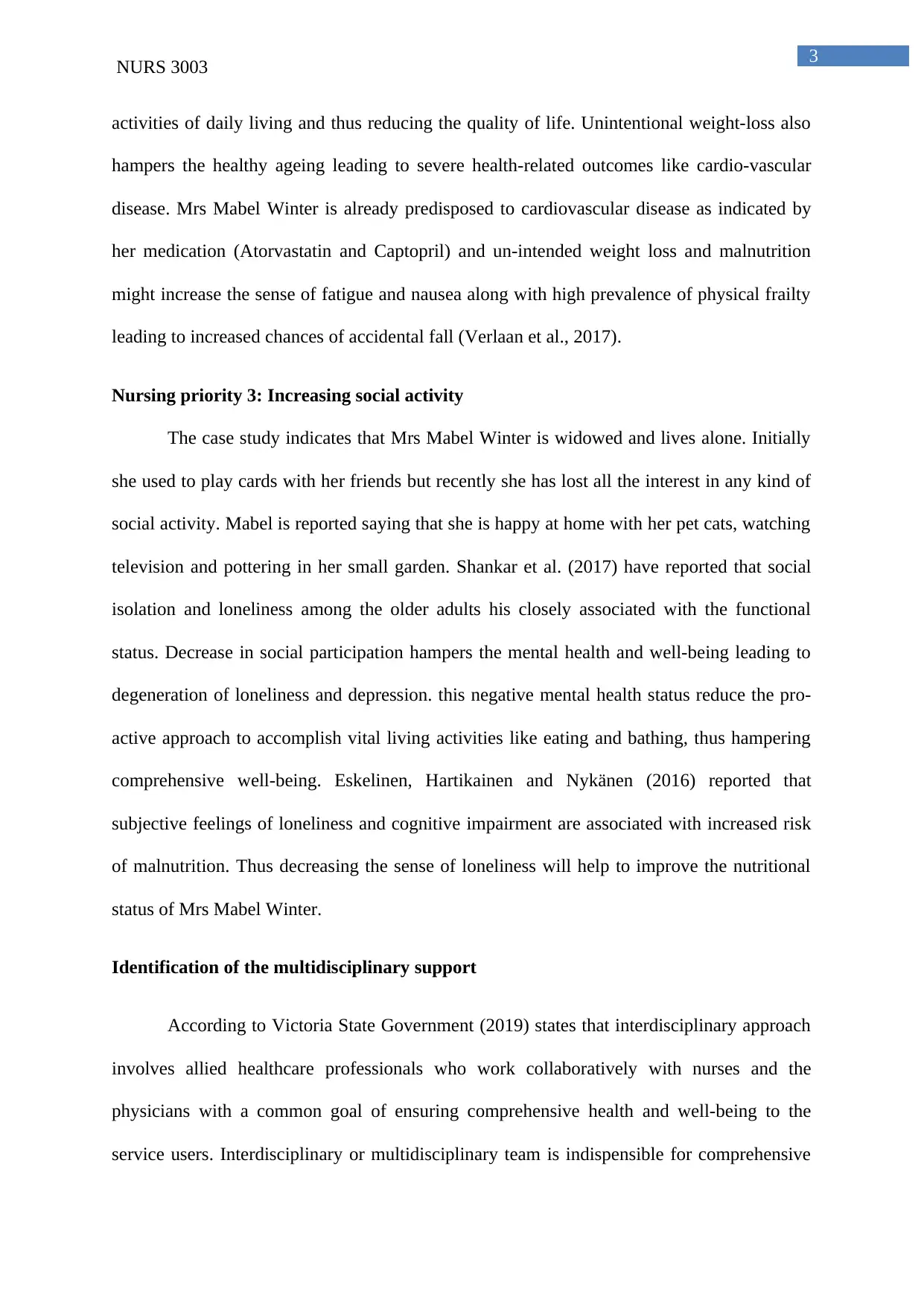
3
NURS 3003
activities of daily living and thus reducing the quality of life. Unintentional weight-loss also
hampers the healthy ageing leading to severe health-related outcomes like cardio-vascular
disease. Mrs Mabel Winter is already predisposed to cardiovascular disease as indicated by
her medication (Atorvastatin and Captopril) and un-intended weight loss and malnutrition
might increase the sense of fatigue and nausea along with high prevalence of physical frailty
leading to increased chances of accidental fall (Verlaan et al., 2017).
Nursing priority 3: Increasing social activity
The case study indicates that Mrs Mabel Winter is widowed and lives alone. Initially
she used to play cards with her friends but recently she has lost all the interest in any kind of
social activity. Mabel is reported saying that she is happy at home with her pet cats, watching
television and pottering in her small garden. Shankar et al. (2017) have reported that social
isolation and loneliness among the older adults his closely associated with the functional
status. Decrease in social participation hampers the mental health and well-being leading to
degeneration of loneliness and depression. this negative mental health status reduce the pro-
active approach to accomplish vital living activities like eating and bathing, thus hampering
comprehensive well-being. Eskelinen, Hartikainen and Nykänen (2016) reported that
subjective feelings of loneliness and cognitive impairment are associated with increased risk
of malnutrition. Thus decreasing the sense of loneliness will help to improve the nutritional
status of Mrs Mabel Winter.
Identification of the multidisciplinary support
According to Victoria State Government (2019) states that interdisciplinary approach
involves allied healthcare professionals who work collaboratively with nurses and the
physicians with a common goal of ensuring comprehensive health and well-being to the
service users. Interdisciplinary or multidisciplinary team is indispensible for comprehensive
NURS 3003
activities of daily living and thus reducing the quality of life. Unintentional weight-loss also
hampers the healthy ageing leading to severe health-related outcomes like cardio-vascular
disease. Mrs Mabel Winter is already predisposed to cardiovascular disease as indicated by
her medication (Atorvastatin and Captopril) and un-intended weight loss and malnutrition
might increase the sense of fatigue and nausea along with high prevalence of physical frailty
leading to increased chances of accidental fall (Verlaan et al., 2017).
Nursing priority 3: Increasing social activity
The case study indicates that Mrs Mabel Winter is widowed and lives alone. Initially
she used to play cards with her friends but recently she has lost all the interest in any kind of
social activity. Mabel is reported saying that she is happy at home with her pet cats, watching
television and pottering in her small garden. Shankar et al. (2017) have reported that social
isolation and loneliness among the older adults his closely associated with the functional
status. Decrease in social participation hampers the mental health and well-being leading to
degeneration of loneliness and depression. this negative mental health status reduce the pro-
active approach to accomplish vital living activities like eating and bathing, thus hampering
comprehensive well-being. Eskelinen, Hartikainen and Nykänen (2016) reported that
subjective feelings of loneliness and cognitive impairment are associated with increased risk
of malnutrition. Thus decreasing the sense of loneliness will help to improve the nutritional
status of Mrs Mabel Winter.
Identification of the multidisciplinary support
According to Victoria State Government (2019) states that interdisciplinary approach
involves allied healthcare professionals who work collaboratively with nurses and the
physicians with a common goal of ensuring comprehensive health and well-being to the
service users. Interdisciplinary or multidisciplinary team is indispensible for comprehensive
Secure Best Marks with AI Grader
Need help grading? Try our AI Grader for instant feedback on your assignments.
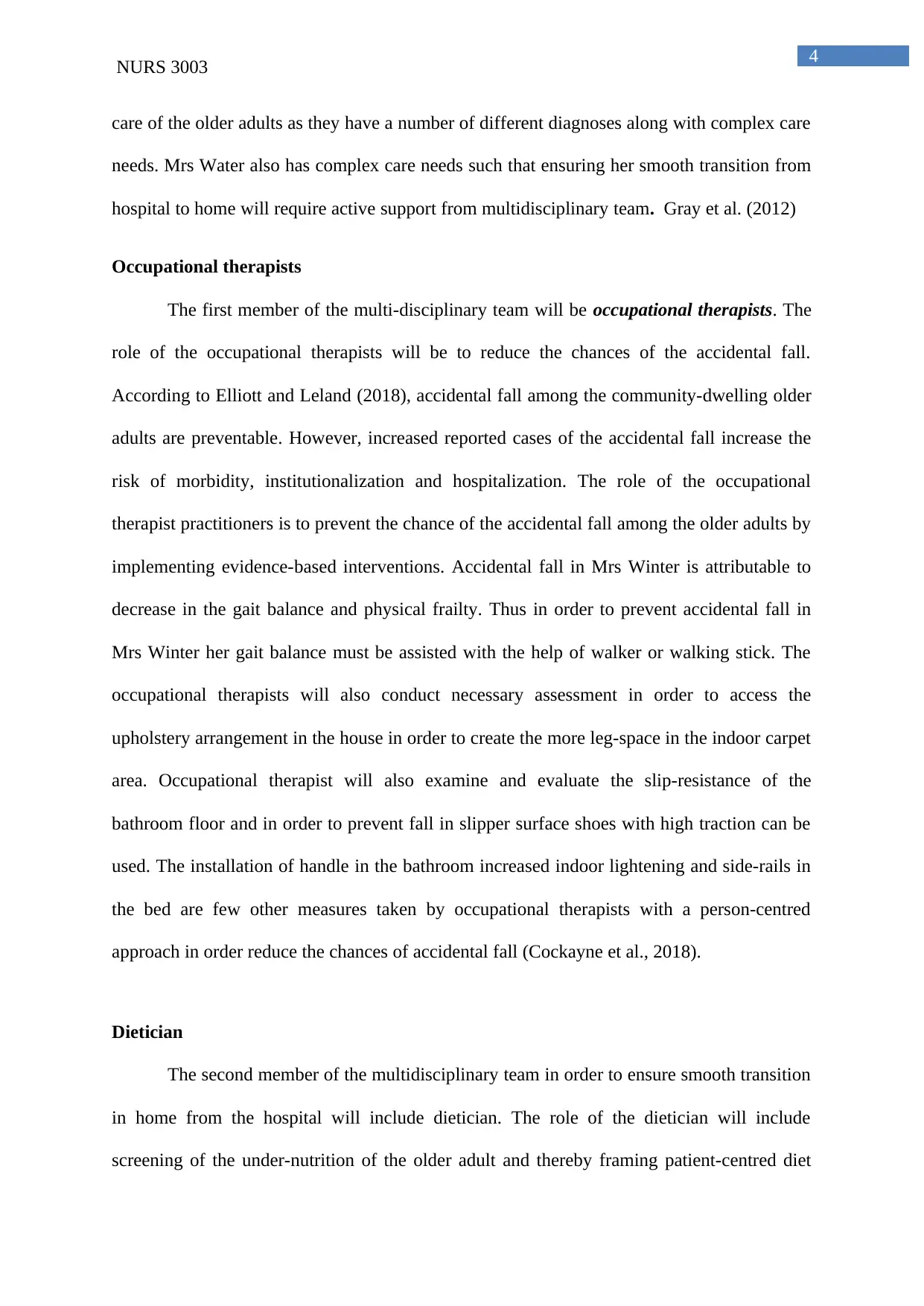
4
NURS 3003
care of the older adults as they have a number of different diagnoses along with complex care
needs. Mrs Water also has complex care needs such that ensuring her smooth transition from
hospital to home will require active support from multidisciplinary team. Gray et al. (2012)
Occupational therapists
The first member of the multi-disciplinary team will be occupational therapists. The
role of the occupational therapists will be to reduce the chances of the accidental fall.
According to Elliott and Leland (2018), accidental fall among the community-dwelling older
adults are preventable. However, increased reported cases of the accidental fall increase the
risk of morbidity, institutionalization and hospitalization. The role of the occupational
therapist practitioners is to prevent the chance of the accidental fall among the older adults by
implementing evidence-based interventions. Accidental fall in Mrs Winter is attributable to
decrease in the gait balance and physical frailty. Thus in order to prevent accidental fall in
Mrs Winter her gait balance must be assisted with the help of walker or walking stick. The
occupational therapists will also conduct necessary assessment in order to access the
upholstery arrangement in the house in order to create the more leg-space in the indoor carpet
area. Occupational therapist will also examine and evaluate the slip-resistance of the
bathroom floor and in order to prevent fall in slipper surface shoes with high traction can be
used. The installation of handle in the bathroom increased indoor lightening and side-rails in
the bed are few other measures taken by occupational therapists with a person-centred
approach in order reduce the chances of accidental fall (Cockayne et al., 2018).
Dietician
The second member of the multidisciplinary team in order to ensure smooth transition
in home from the hospital will include dietician. The role of the dietician will include
screening of the under-nutrition of the older adult and thereby framing patient-centred diet
NURS 3003
care of the older adults as they have a number of different diagnoses along with complex care
needs. Mrs Water also has complex care needs such that ensuring her smooth transition from
hospital to home will require active support from multidisciplinary team. Gray et al. (2012)
Occupational therapists
The first member of the multi-disciplinary team will be occupational therapists. The
role of the occupational therapists will be to reduce the chances of the accidental fall.
According to Elliott and Leland (2018), accidental fall among the community-dwelling older
adults are preventable. However, increased reported cases of the accidental fall increase the
risk of morbidity, institutionalization and hospitalization. The role of the occupational
therapist practitioners is to prevent the chance of the accidental fall among the older adults by
implementing evidence-based interventions. Accidental fall in Mrs Winter is attributable to
decrease in the gait balance and physical frailty. Thus in order to prevent accidental fall in
Mrs Winter her gait balance must be assisted with the help of walker or walking stick. The
occupational therapists will also conduct necessary assessment in order to access the
upholstery arrangement in the house in order to create the more leg-space in the indoor carpet
area. Occupational therapist will also examine and evaluate the slip-resistance of the
bathroom floor and in order to prevent fall in slipper surface shoes with high traction can be
used. The installation of handle in the bathroom increased indoor lightening and side-rails in
the bed are few other measures taken by occupational therapists with a person-centred
approach in order reduce the chances of accidental fall (Cockayne et al., 2018).
Dietician
The second member of the multidisciplinary team in order to ensure smooth transition
in home from the hospital will include dietician. The role of the dietician will include
screening of the under-nutrition of the older adult and thereby framing patient-centred diet
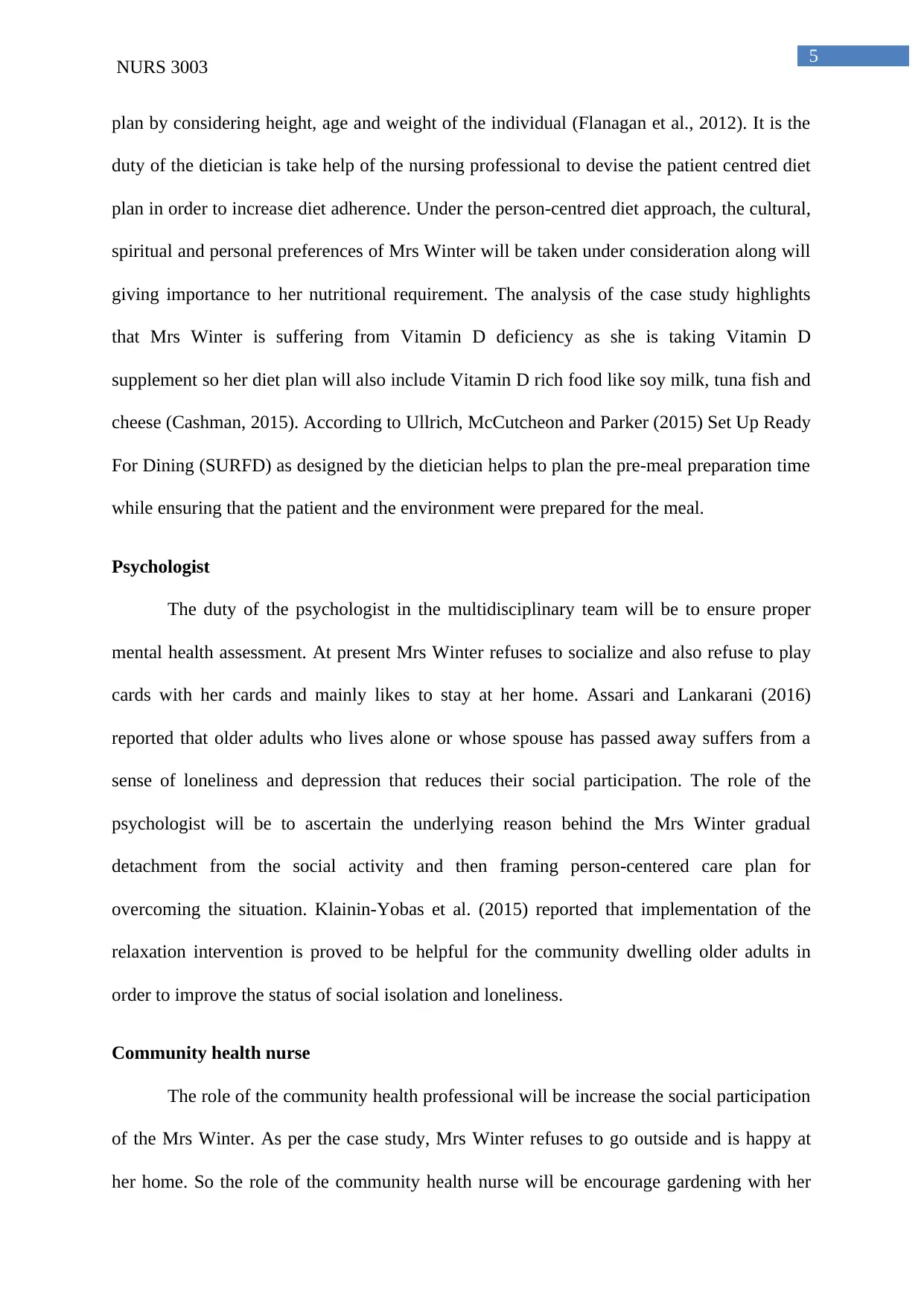
5
NURS 3003
plan by considering height, age and weight of the individual (Flanagan et al., 2012). It is the
duty of the dietician is take help of the nursing professional to devise the patient centred diet
plan in order to increase diet adherence. Under the person-centred diet approach, the cultural,
spiritual and personal preferences of Mrs Winter will be taken under consideration along will
giving importance to her nutritional requirement. The analysis of the case study highlights
that Mrs Winter is suffering from Vitamin D deficiency as she is taking Vitamin D
supplement so her diet plan will also include Vitamin D rich food like soy milk, tuna fish and
cheese (Cashman, 2015). According to Ullrich, McCutcheon and Parker (2015) Set Up Ready
For Dining (SURFD) as designed by the dietician helps to plan the pre-meal preparation time
while ensuring that the patient and the environment were prepared for the meal.
Psychologist
The duty of the psychologist in the multidisciplinary team will be to ensure proper
mental health assessment. At present Mrs Winter refuses to socialize and also refuse to play
cards with her cards and mainly likes to stay at her home. Assari and Lankarani (2016)
reported that older adults who lives alone or whose spouse has passed away suffers from a
sense of loneliness and depression that reduces their social participation. The role of the
psychologist will be to ascertain the underlying reason behind the Mrs Winter gradual
detachment from the social activity and then framing person-centered care plan for
overcoming the situation. Klainin-Yobas et al. (2015) reported that implementation of the
relaxation intervention is proved to be helpful for the community dwelling older adults in
order to improve the status of social isolation and loneliness.
Community health nurse
The role of the community health professional will be increase the social participation
of the Mrs Winter. As per the case study, Mrs Winter refuses to go outside and is happy at
her home. So the role of the community health nurse will be encourage gardening with her
NURS 3003
plan by considering height, age and weight of the individual (Flanagan et al., 2012). It is the
duty of the dietician is take help of the nursing professional to devise the patient centred diet
plan in order to increase diet adherence. Under the person-centred diet approach, the cultural,
spiritual and personal preferences of Mrs Winter will be taken under consideration along will
giving importance to her nutritional requirement. The analysis of the case study highlights
that Mrs Winter is suffering from Vitamin D deficiency as she is taking Vitamin D
supplement so her diet plan will also include Vitamin D rich food like soy milk, tuna fish and
cheese (Cashman, 2015). According to Ullrich, McCutcheon and Parker (2015) Set Up Ready
For Dining (SURFD) as designed by the dietician helps to plan the pre-meal preparation time
while ensuring that the patient and the environment were prepared for the meal.
Psychologist
The duty of the psychologist in the multidisciplinary team will be to ensure proper
mental health assessment. At present Mrs Winter refuses to socialize and also refuse to play
cards with her cards and mainly likes to stay at her home. Assari and Lankarani (2016)
reported that older adults who lives alone or whose spouse has passed away suffers from a
sense of loneliness and depression that reduces their social participation. The role of the
psychologist will be to ascertain the underlying reason behind the Mrs Winter gradual
detachment from the social activity and then framing person-centered care plan for
overcoming the situation. Klainin-Yobas et al. (2015) reported that implementation of the
relaxation intervention is proved to be helpful for the community dwelling older adults in
order to improve the status of social isolation and loneliness.
Community health nurse
The role of the community health professional will be increase the social participation
of the Mrs Winter. As per the case study, Mrs Winter refuses to go outside and is happy at
her home. So the role of the community health nurse will be encourage gardening with her
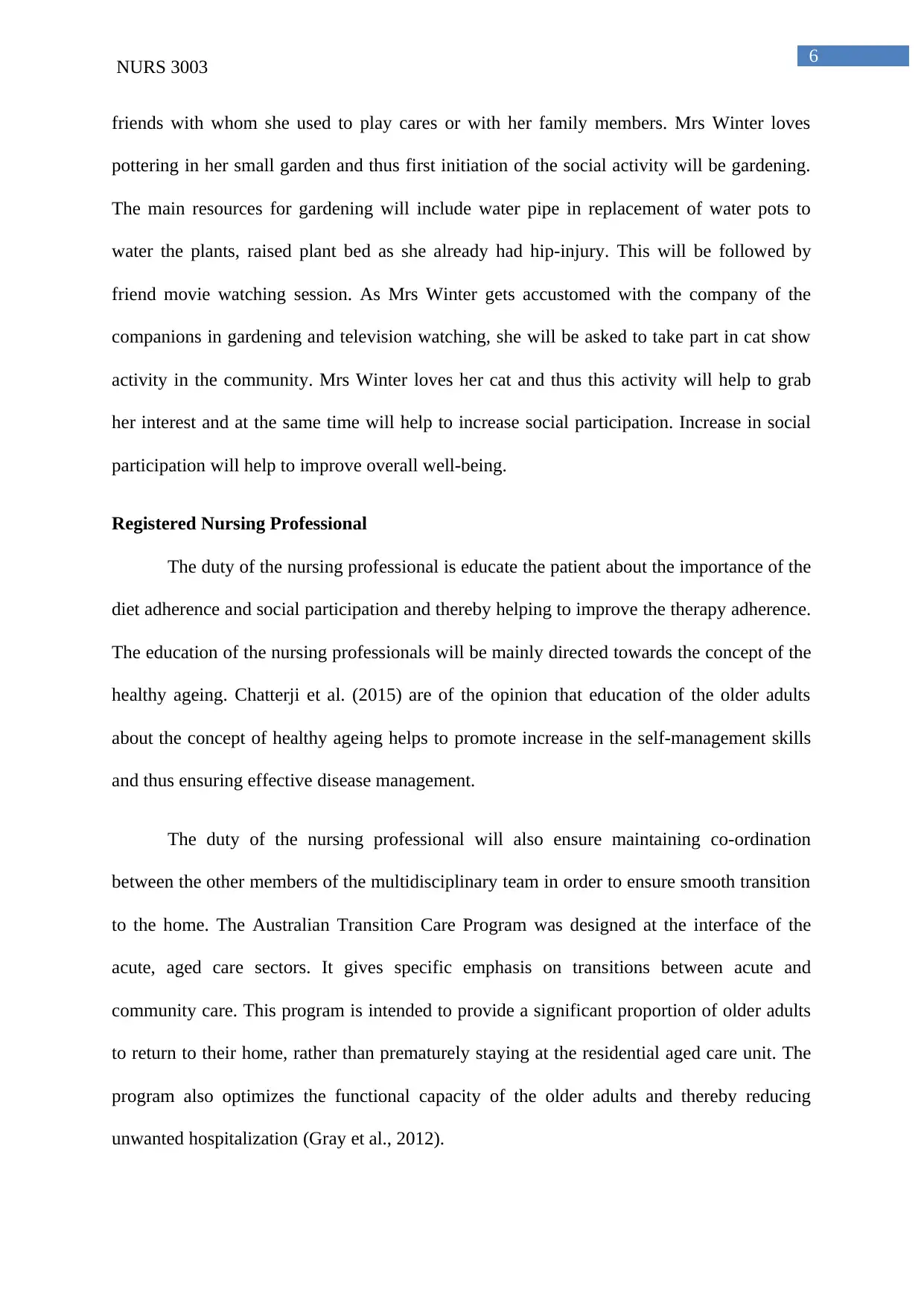
6
NURS 3003
friends with whom she used to play cares or with her family members. Mrs Winter loves
pottering in her small garden and thus first initiation of the social activity will be gardening.
The main resources for gardening will include water pipe in replacement of water pots to
water the plants, raised plant bed as she already had hip-injury. This will be followed by
friend movie watching session. As Mrs Winter gets accustomed with the company of the
companions in gardening and television watching, she will be asked to take part in cat show
activity in the community. Mrs Winter loves her cat and thus this activity will help to grab
her interest and at the same time will help to increase social participation. Increase in social
participation will help to improve overall well-being.
Registered Nursing Professional
The duty of the nursing professional is educate the patient about the importance of the
diet adherence and social participation and thereby helping to improve the therapy adherence.
The education of the nursing professionals will be mainly directed towards the concept of the
healthy ageing. Chatterji et al. (2015) are of the opinion that education of the older adults
about the concept of healthy ageing helps to promote increase in the self-management skills
and thus ensuring effective disease management.
The duty of the nursing professional will also ensure maintaining co-ordination
between the other members of the multidisciplinary team in order to ensure smooth transition
to the home. The Australian Transition Care Program was designed at the interface of the
acute, aged care sectors. It gives specific emphasis on transitions between acute and
community care. This program is intended to provide a significant proportion of older adults
to return to their home, rather than prematurely staying at the residential aged care unit. The
program also optimizes the functional capacity of the older adults and thereby reducing
unwanted hospitalization (Gray et al., 2012).
NURS 3003
friends with whom she used to play cares or with her family members. Mrs Winter loves
pottering in her small garden and thus first initiation of the social activity will be gardening.
The main resources for gardening will include water pipe in replacement of water pots to
water the plants, raised plant bed as she already had hip-injury. This will be followed by
friend movie watching session. As Mrs Winter gets accustomed with the company of the
companions in gardening and television watching, she will be asked to take part in cat show
activity in the community. Mrs Winter loves her cat and thus this activity will help to grab
her interest and at the same time will help to increase social participation. Increase in social
participation will help to improve overall well-being.
Registered Nursing Professional
The duty of the nursing professional is educate the patient about the importance of the
diet adherence and social participation and thereby helping to improve the therapy adherence.
The education of the nursing professionals will be mainly directed towards the concept of the
healthy ageing. Chatterji et al. (2015) are of the opinion that education of the older adults
about the concept of healthy ageing helps to promote increase in the self-management skills
and thus ensuring effective disease management.
The duty of the nursing professional will also ensure maintaining co-ordination
between the other members of the multidisciplinary team in order to ensure smooth transition
to the home. The Australian Transition Care Program was designed at the interface of the
acute, aged care sectors. It gives specific emphasis on transitions between acute and
community care. This program is intended to provide a significant proportion of older adults
to return to their home, rather than prematurely staying at the residential aged care unit. The
program also optimizes the functional capacity of the older adults and thereby reducing
unwanted hospitalization (Gray et al., 2012).
Paraphrase This Document
Need a fresh take? Get an instant paraphrase of this document with our AI Paraphraser
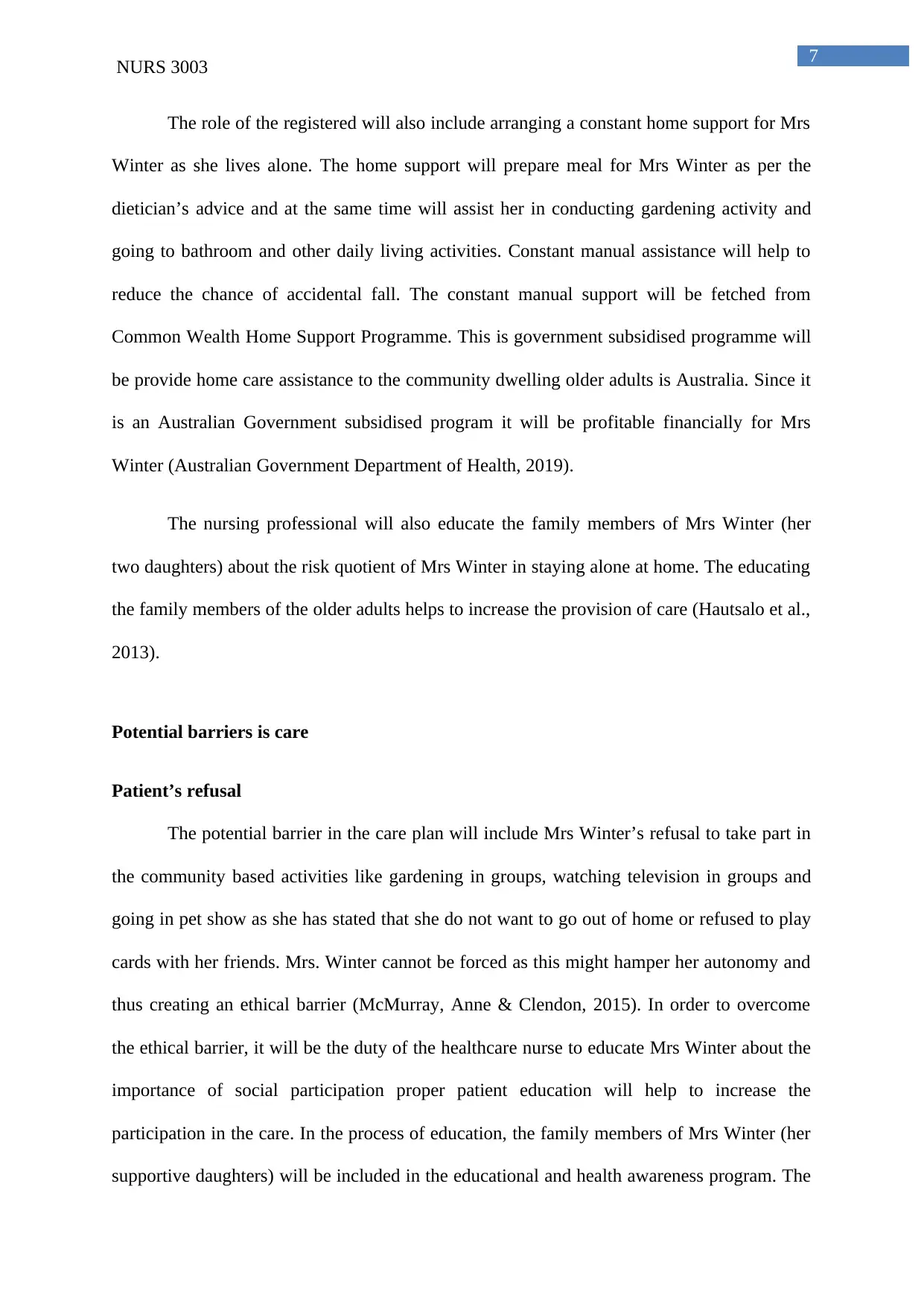
7
NURS 3003
The role of the registered will also include arranging a constant home support for Mrs
Winter as she lives alone. The home support will prepare meal for Mrs Winter as per the
dietician’s advice and at the same time will assist her in conducting gardening activity and
going to bathroom and other daily living activities. Constant manual assistance will help to
reduce the chance of accidental fall. The constant manual support will be fetched from
Common Wealth Home Support Programme. This is government subsidised programme will
be provide home care assistance to the community dwelling older adults is Australia. Since it
is an Australian Government subsidised program it will be profitable financially for Mrs
Winter (Australian Government Department of Health, 2019).
The nursing professional will also educate the family members of Mrs Winter (her
two daughters) about the risk quotient of Mrs Winter in staying alone at home. The educating
the family members of the older adults helps to increase the provision of care (Hautsalo et al.,
2013).
Potential barriers is care
Patient’s refusal
The potential barrier in the care plan will include Mrs Winter’s refusal to take part in
the community based activities like gardening in groups, watching television in groups and
going in pet show as she has stated that she do not want to go out of home or refused to play
cards with her friends. Mrs. Winter cannot be forced as this might hamper her autonomy and
thus creating an ethical barrier (McMurray, Anne & Clendon, 2015). In order to overcome
the ethical barrier, it will be the duty of the healthcare nurse to educate Mrs Winter about the
importance of social participation proper patient education will help to increase the
participation in the care. In the process of education, the family members of Mrs Winter (her
supportive daughters) will be included in the educational and health awareness program. The
NURS 3003
The role of the registered will also include arranging a constant home support for Mrs
Winter as she lives alone. The home support will prepare meal for Mrs Winter as per the
dietician’s advice and at the same time will assist her in conducting gardening activity and
going to bathroom and other daily living activities. Constant manual assistance will help to
reduce the chance of accidental fall. The constant manual support will be fetched from
Common Wealth Home Support Programme. This is government subsidised programme will
be provide home care assistance to the community dwelling older adults is Australia. Since it
is an Australian Government subsidised program it will be profitable financially for Mrs
Winter (Australian Government Department of Health, 2019).
The nursing professional will also educate the family members of Mrs Winter (her
two daughters) about the risk quotient of Mrs Winter in staying alone at home. The educating
the family members of the older adults helps to increase the provision of care (Hautsalo et al.,
2013).
Potential barriers is care
Patient’s refusal
The potential barrier in the care plan will include Mrs Winter’s refusal to take part in
the community based activities like gardening in groups, watching television in groups and
going in pet show as she has stated that she do not want to go out of home or refused to play
cards with her friends. Mrs. Winter cannot be forced as this might hamper her autonomy and
thus creating an ethical barrier (McMurray, Anne & Clendon, 2015). In order to overcome
the ethical barrier, it will be the duty of the healthcare nurse to educate Mrs Winter about the
importance of social participation proper patient education will help to increase the
participation in the care. In the process of education, the family members of Mrs Winter (her
supportive daughters) will be included in the educational and health awareness program. The
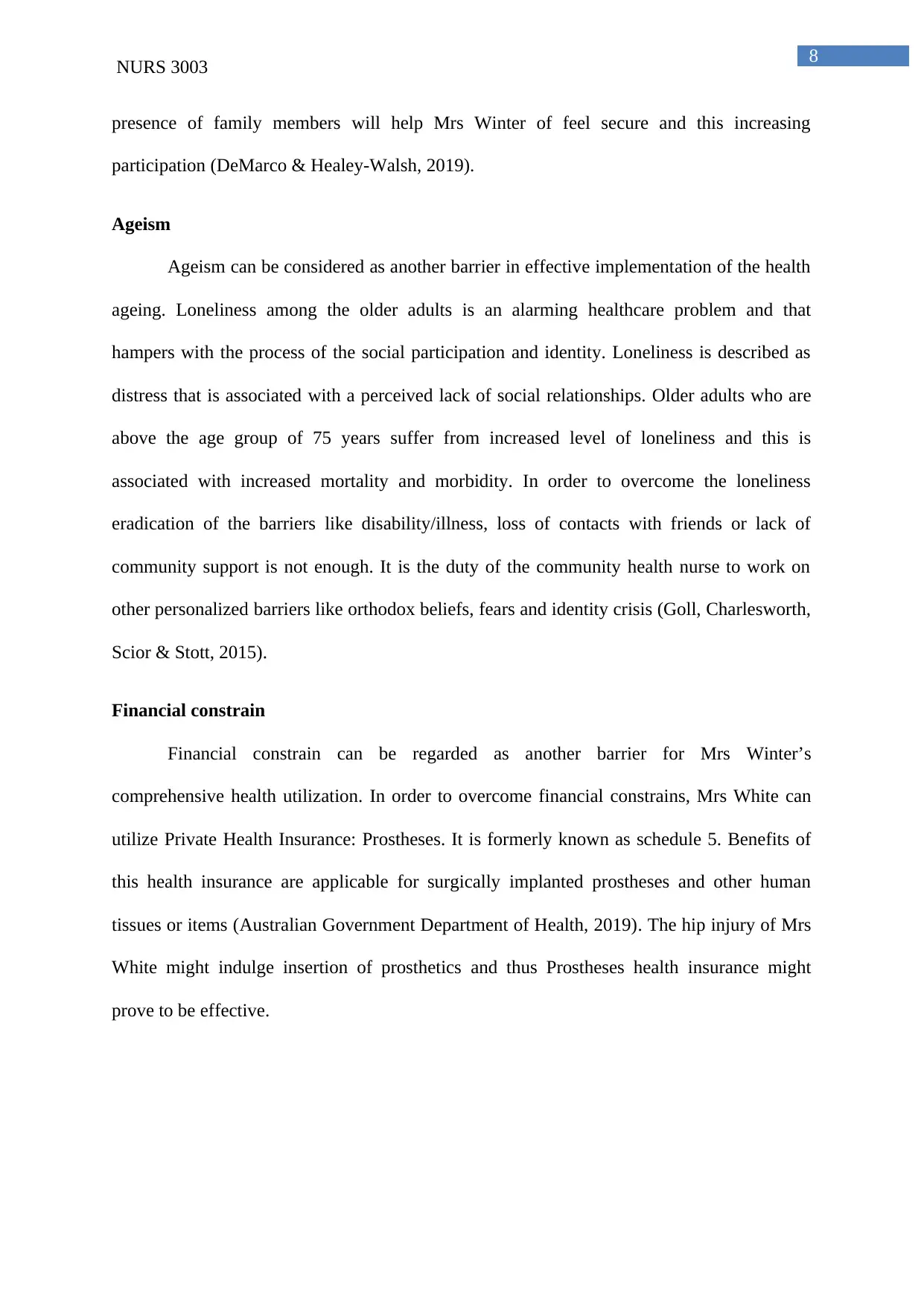
8
NURS 3003
presence of family members will help Mrs Winter of feel secure and this increasing
participation (DeMarco & Healey-Walsh, 2019).
Ageism
Ageism can be considered as another barrier in effective implementation of the health
ageing. Loneliness among the older adults is an alarming healthcare problem and that
hampers with the process of the social participation and identity. Loneliness is described as
distress that is associated with a perceived lack of social relationships. Older adults who are
above the age group of 75 years suffer from increased level of loneliness and this is
associated with increased mortality and morbidity. In order to overcome the loneliness
eradication of the barriers like disability/illness, loss of contacts with friends or lack of
community support is not enough. It is the duty of the community health nurse to work on
other personalized barriers like orthodox beliefs, fears and identity crisis (Goll, Charlesworth,
Scior & Stott, 2015).
Financial constrain
Financial constrain can be regarded as another barrier for Mrs Winter’s
comprehensive health utilization. In order to overcome financial constrains, Mrs White can
utilize Private Health Insurance: Prostheses. It is formerly known as schedule 5. Benefits of
this health insurance are applicable for surgically implanted prostheses and other human
tissues or items (Australian Government Department of Health, 2019). The hip injury of Mrs
White might indulge insertion of prosthetics and thus Prostheses health insurance might
prove to be effective.
NURS 3003
presence of family members will help Mrs Winter of feel secure and this increasing
participation (DeMarco & Healey-Walsh, 2019).
Ageism
Ageism can be considered as another barrier in effective implementation of the health
ageing. Loneliness among the older adults is an alarming healthcare problem and that
hampers with the process of the social participation and identity. Loneliness is described as
distress that is associated with a perceived lack of social relationships. Older adults who are
above the age group of 75 years suffer from increased level of loneliness and this is
associated with increased mortality and morbidity. In order to overcome the loneliness
eradication of the barriers like disability/illness, loss of contacts with friends or lack of
community support is not enough. It is the duty of the community health nurse to work on
other personalized barriers like orthodox beliefs, fears and identity crisis (Goll, Charlesworth,
Scior & Stott, 2015).
Financial constrain
Financial constrain can be regarded as another barrier for Mrs Winter’s
comprehensive health utilization. In order to overcome financial constrains, Mrs White can
utilize Private Health Insurance: Prostheses. It is formerly known as schedule 5. Benefits of
this health insurance are applicable for surgically implanted prostheses and other human
tissues or items (Australian Government Department of Health, 2019). The hip injury of Mrs
White might indulge insertion of prosthetics and thus Prostheses health insurance might
prove to be effective.
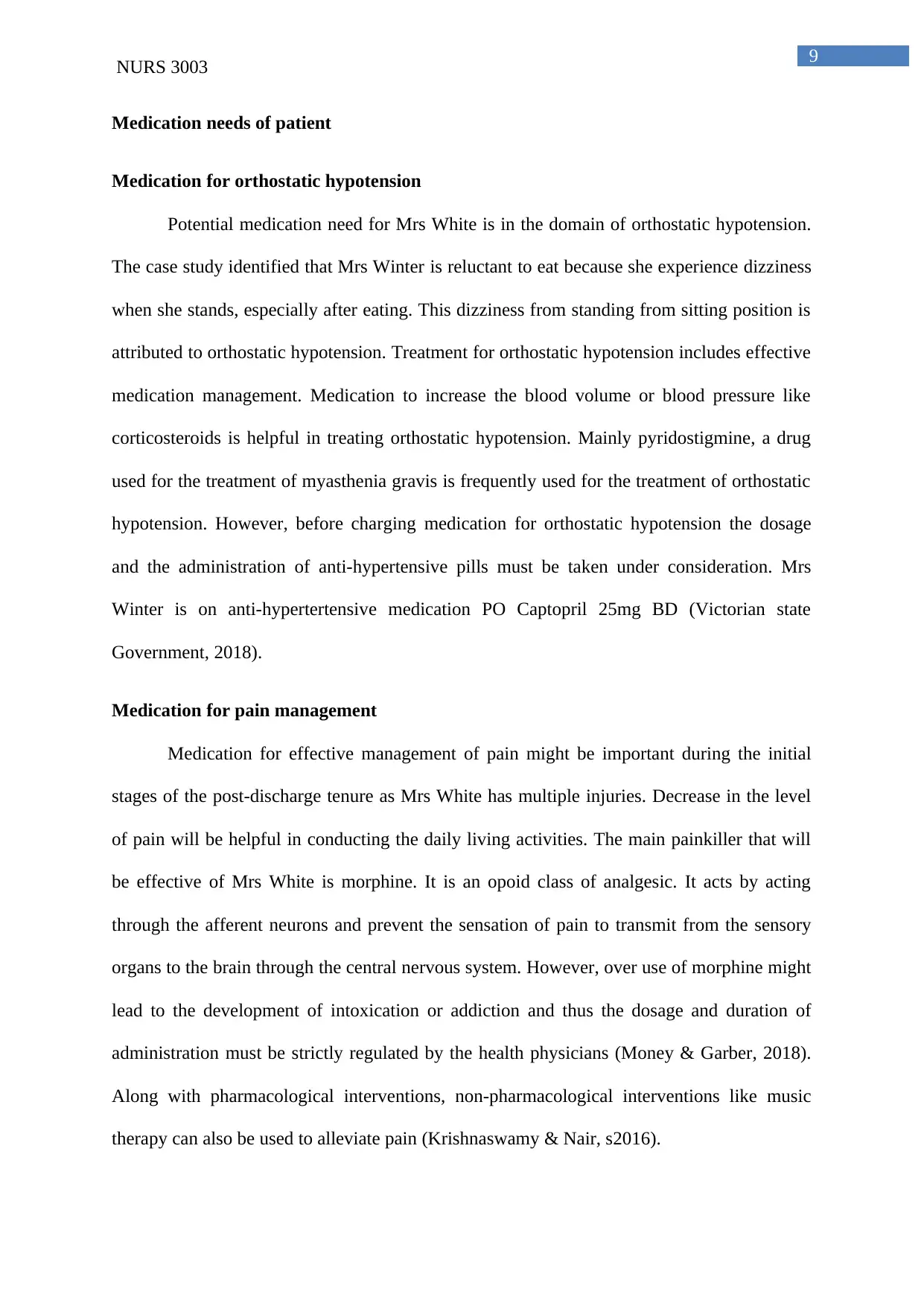
9
NURS 3003
Medication needs of patient
Medication for orthostatic hypotension
Potential medication need for Mrs White is in the domain of orthostatic hypotension.
The case study identified that Mrs Winter is reluctant to eat because she experience dizziness
when she stands, especially after eating. This dizziness from standing from sitting position is
attributed to orthostatic hypotension. Treatment for orthostatic hypotension includes effective
medication management. Medication to increase the blood volume or blood pressure like
corticosteroids is helpful in treating orthostatic hypotension. Mainly pyridostigmine, a drug
used for the treatment of myasthenia gravis is frequently used for the treatment of orthostatic
hypotension. However, before charging medication for orthostatic hypotension the dosage
and the administration of anti-hypertensive pills must be taken under consideration. Mrs
Winter is on anti-hypertertensive medication PO Captopril 25mg BD (Victorian state
Government, 2018).
Medication for pain management
Medication for effective management of pain might be important during the initial
stages of the post-discharge tenure as Mrs White has multiple injuries. Decrease in the level
of pain will be helpful in conducting the daily living activities. The main painkiller that will
be effective of Mrs White is morphine. It is an opoid class of analgesic. It acts by acting
through the afferent neurons and prevent the sensation of pain to transmit from the sensory
organs to the brain through the central nervous system. However, over use of morphine might
lead to the development of intoxication or addiction and thus the dosage and duration of
administration must be strictly regulated by the health physicians (Money & Garber, 2018).
Along with pharmacological interventions, non-pharmacological interventions like music
therapy can also be used to alleviate pain (Krishnaswamy & Nair, s2016).
NURS 3003
Medication needs of patient
Medication for orthostatic hypotension
Potential medication need for Mrs White is in the domain of orthostatic hypotension.
The case study identified that Mrs Winter is reluctant to eat because she experience dizziness
when she stands, especially after eating. This dizziness from standing from sitting position is
attributed to orthostatic hypotension. Treatment for orthostatic hypotension includes effective
medication management. Medication to increase the blood volume or blood pressure like
corticosteroids is helpful in treating orthostatic hypotension. Mainly pyridostigmine, a drug
used for the treatment of myasthenia gravis is frequently used for the treatment of orthostatic
hypotension. However, before charging medication for orthostatic hypotension the dosage
and the administration of anti-hypertensive pills must be taken under consideration. Mrs
Winter is on anti-hypertertensive medication PO Captopril 25mg BD (Victorian state
Government, 2018).
Medication for pain management
Medication for effective management of pain might be important during the initial
stages of the post-discharge tenure as Mrs White has multiple injuries. Decrease in the level
of pain will be helpful in conducting the daily living activities. The main painkiller that will
be effective of Mrs White is morphine. It is an opoid class of analgesic. It acts by acting
through the afferent neurons and prevent the sensation of pain to transmit from the sensory
organs to the brain through the central nervous system. However, over use of morphine might
lead to the development of intoxication or addiction and thus the dosage and duration of
administration must be strictly regulated by the health physicians (Money & Garber, 2018).
Along with pharmacological interventions, non-pharmacological interventions like music
therapy can also be used to alleviate pain (Krishnaswamy & Nair, s2016).
Secure Best Marks with AI Grader
Need help grading? Try our AI Grader for instant feedback on your assignments.
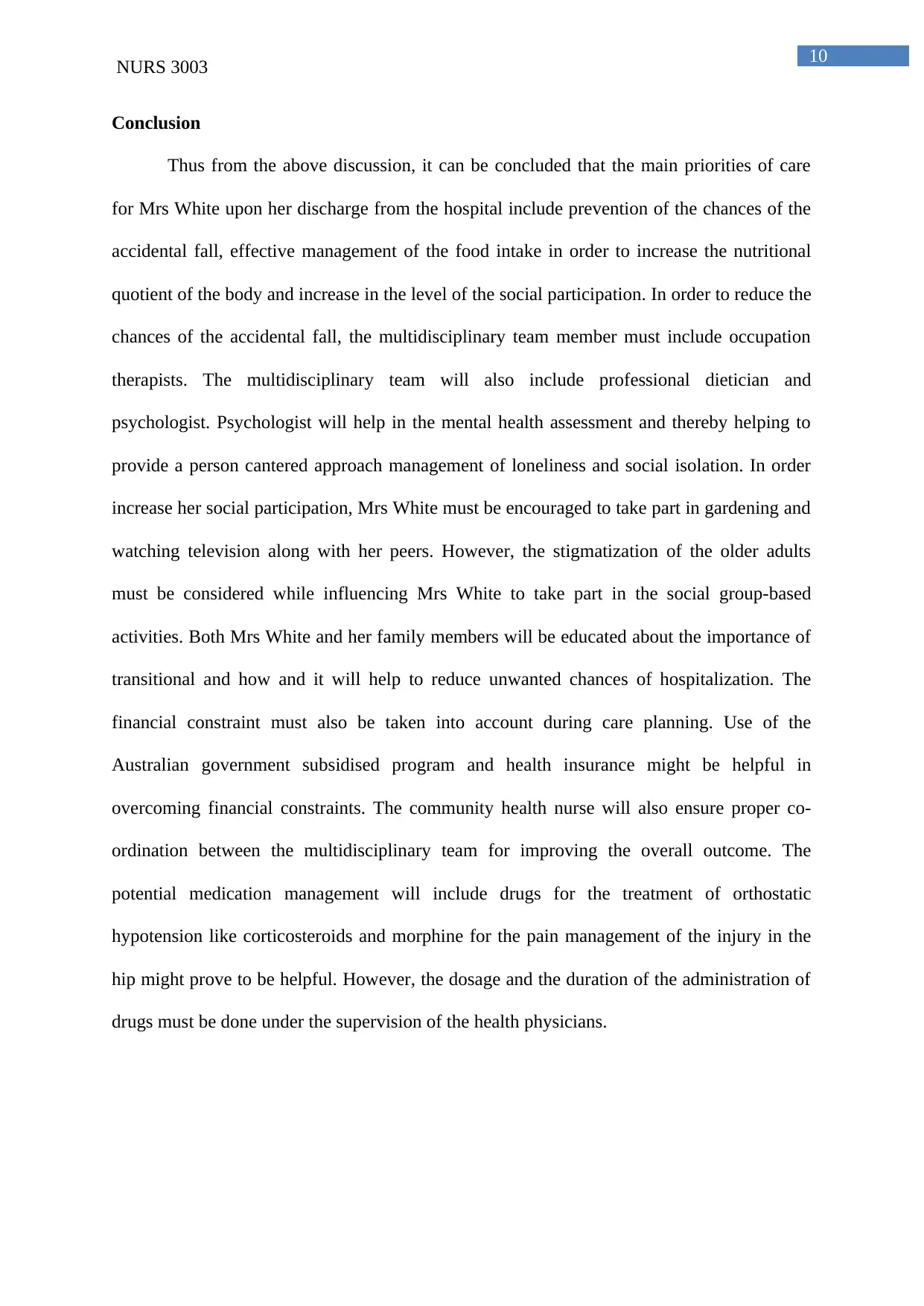
10
NURS 3003
Conclusion
Thus from the above discussion, it can be concluded that the main priorities of care
for Mrs White upon her discharge from the hospital include prevention of the chances of the
accidental fall, effective management of the food intake in order to increase the nutritional
quotient of the body and increase in the level of the social participation. In order to reduce the
chances of the accidental fall, the multidisciplinary team member must include occupation
therapists. The multidisciplinary team will also include professional dietician and
psychologist. Psychologist will help in the mental health assessment and thereby helping to
provide a person cantered approach management of loneliness and social isolation. In order
increase her social participation, Mrs White must be encouraged to take part in gardening and
watching television along with her peers. However, the stigmatization of the older adults
must be considered while influencing Mrs White to take part in the social group-based
activities. Both Mrs White and her family members will be educated about the importance of
transitional and how and it will help to reduce unwanted chances of hospitalization. The
financial constraint must also be taken into account during care planning. Use of the
Australian government subsidised program and health insurance might be helpful in
overcoming financial constraints. The community health nurse will also ensure proper co-
ordination between the multidisciplinary team for improving the overall outcome. The
potential medication management will include drugs for the treatment of orthostatic
hypotension like corticosteroids and morphine for the pain management of the injury in the
hip might prove to be helpful. However, the dosage and the duration of the administration of
drugs must be done under the supervision of the health physicians.
NURS 3003
Conclusion
Thus from the above discussion, it can be concluded that the main priorities of care
for Mrs White upon her discharge from the hospital include prevention of the chances of the
accidental fall, effective management of the food intake in order to increase the nutritional
quotient of the body and increase in the level of the social participation. In order to reduce the
chances of the accidental fall, the multidisciplinary team member must include occupation
therapists. The multidisciplinary team will also include professional dietician and
psychologist. Psychologist will help in the mental health assessment and thereby helping to
provide a person cantered approach management of loneliness and social isolation. In order
increase her social participation, Mrs White must be encouraged to take part in gardening and
watching television along with her peers. However, the stigmatization of the older adults
must be considered while influencing Mrs White to take part in the social group-based
activities. Both Mrs White and her family members will be educated about the importance of
transitional and how and it will help to reduce unwanted chances of hospitalization. The
financial constraint must also be taken into account during care planning. Use of the
Australian government subsidised program and health insurance might be helpful in
overcoming financial constraints. The community health nurse will also ensure proper co-
ordination between the multidisciplinary team for improving the overall outcome. The
potential medication management will include drugs for the treatment of orthostatic
hypotension like corticosteroids and morphine for the pain management of the injury in the
hip might prove to be helpful. However, the dosage and the duration of the administration of
drugs must be done under the supervision of the health physicians.
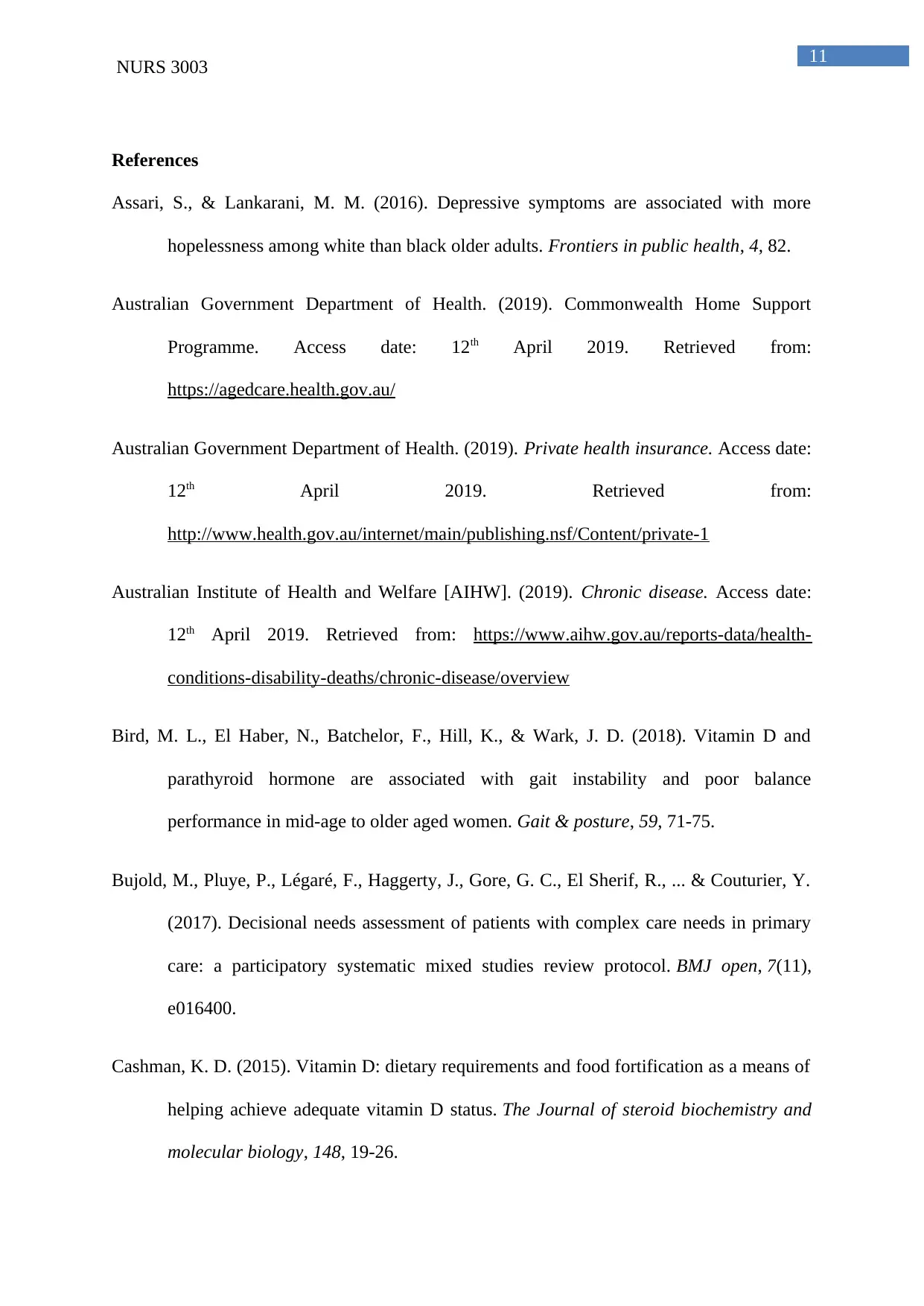
11
NURS 3003
References
Assari, S., & Lankarani, M. M. (2016). Depressive symptoms are associated with more
hopelessness among white than black older adults. Frontiers in public health, 4, 82.
Australian Government Department of Health. (2019). Commonwealth Home Support
Programme. Access date: 12th April 2019. Retrieved from:
https://agedcare.health.gov.au/
Australian Government Department of Health. (2019). Private health insurance. Access date:
12th April 2019. Retrieved from:
http://www.health.gov.au/internet/main/publishing.nsf/Content/private-1
Australian Institute of Health and Welfare [AIHW]. (2019). Chronic disease. Access date:
12th April 2019. Retrieved from: https://www.aihw.gov.au/reports-data/health-
conditions-disability-deaths/chronic-disease/overview
Bird, M. L., El Haber, N., Batchelor, F., Hill, K., & Wark, J. D. (2018). Vitamin D and
parathyroid hormone are associated with gait instability and poor balance
performance in mid-age to older aged women. Gait & posture, 59, 71-75.
Bujold, M., Pluye, P., Légaré, F., Haggerty, J., Gore, G. C., El Sherif, R., ... & Couturier, Y.
(2017). Decisional needs assessment of patients with complex care needs in primary
care: a participatory systematic mixed studies review protocol. BMJ open, 7(11),
e016400.
Cashman, K. D. (2015). Vitamin D: dietary requirements and food fortification as a means of
helping achieve adequate vitamin D status. The Journal of steroid biochemistry and
molecular biology, 148, 19-26.
NURS 3003
References
Assari, S., & Lankarani, M. M. (2016). Depressive symptoms are associated with more
hopelessness among white than black older adults. Frontiers in public health, 4, 82.
Australian Government Department of Health. (2019). Commonwealth Home Support
Programme. Access date: 12th April 2019. Retrieved from:
https://agedcare.health.gov.au/
Australian Government Department of Health. (2019). Private health insurance. Access date:
12th April 2019. Retrieved from:
http://www.health.gov.au/internet/main/publishing.nsf/Content/private-1
Australian Institute of Health and Welfare [AIHW]. (2019). Chronic disease. Access date:
12th April 2019. Retrieved from: https://www.aihw.gov.au/reports-data/health-
conditions-disability-deaths/chronic-disease/overview
Bird, M. L., El Haber, N., Batchelor, F., Hill, K., & Wark, J. D. (2018). Vitamin D and
parathyroid hormone are associated with gait instability and poor balance
performance in mid-age to older aged women. Gait & posture, 59, 71-75.
Bujold, M., Pluye, P., Légaré, F., Haggerty, J., Gore, G. C., El Sherif, R., ... & Couturier, Y.
(2017). Decisional needs assessment of patients with complex care needs in primary
care: a participatory systematic mixed studies review protocol. BMJ open, 7(11),
e016400.
Cashman, K. D. (2015). Vitamin D: dietary requirements and food fortification as a means of
helping achieve adequate vitamin D status. The Journal of steroid biochemistry and
molecular biology, 148, 19-26.
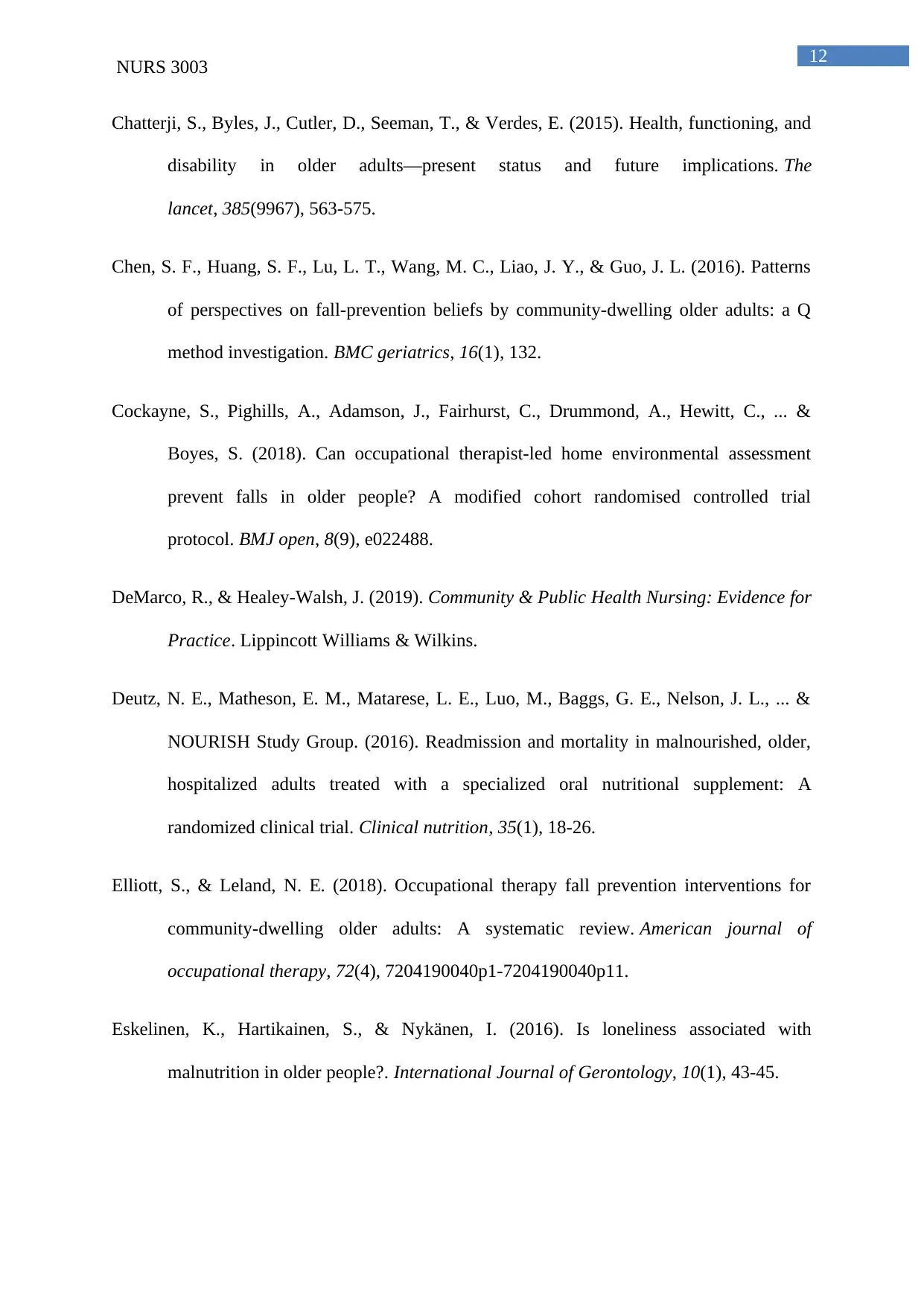
12
NURS 3003
Chatterji, S., Byles, J., Cutler, D., Seeman, T., & Verdes, E. (2015). Health, functioning, and
disability in older adults—present status and future implications. The
lancet, 385(9967), 563-575.
Chen, S. F., Huang, S. F., Lu, L. T., Wang, M. C., Liao, J. Y., & Guo, J. L. (2016). Patterns
of perspectives on fall-prevention beliefs by community-dwelling older adults: a Q
method investigation. BMC geriatrics, 16(1), 132.
Cockayne, S., Pighills, A., Adamson, J., Fairhurst, C., Drummond, A., Hewitt, C., ... &
Boyes, S. (2018). Can occupational therapist-led home environmental assessment
prevent falls in older people? A modified cohort randomised controlled trial
protocol. BMJ open, 8(9), e022488.
DeMarco, R., & Healey-Walsh, J. (2019). Community & Public Health Nursing: Evidence for
Practice. Lippincott Williams & Wilkins.
Deutz, N. E., Matheson, E. M., Matarese, L. E., Luo, M., Baggs, G. E., Nelson, J. L., ... &
NOURISH Study Group. (2016). Readmission and mortality in malnourished, older,
hospitalized adults treated with a specialized oral nutritional supplement: A
randomized clinical trial. Clinical nutrition, 35(1), 18-26.
Elliott, S., & Leland, N. E. (2018). Occupational therapy fall prevention interventions for
community-dwelling older adults: A systematic review. American journal of
occupational therapy, 72(4), 7204190040p1-7204190040p11.
Eskelinen, K., Hartikainen, S., & Nykänen, I. (2016). Is loneliness associated with
malnutrition in older people?. International Journal of Gerontology, 10(1), 43-45.
NURS 3003
Chatterji, S., Byles, J., Cutler, D., Seeman, T., & Verdes, E. (2015). Health, functioning, and
disability in older adults—present status and future implications. The
lancet, 385(9967), 563-575.
Chen, S. F., Huang, S. F., Lu, L. T., Wang, M. C., Liao, J. Y., & Guo, J. L. (2016). Patterns
of perspectives on fall-prevention beliefs by community-dwelling older adults: a Q
method investigation. BMC geriatrics, 16(1), 132.
Cockayne, S., Pighills, A., Adamson, J., Fairhurst, C., Drummond, A., Hewitt, C., ... &
Boyes, S. (2018). Can occupational therapist-led home environmental assessment
prevent falls in older people? A modified cohort randomised controlled trial
protocol. BMJ open, 8(9), e022488.
DeMarco, R., & Healey-Walsh, J. (2019). Community & Public Health Nursing: Evidence for
Practice. Lippincott Williams & Wilkins.
Deutz, N. E., Matheson, E. M., Matarese, L. E., Luo, M., Baggs, G. E., Nelson, J. L., ... &
NOURISH Study Group. (2016). Readmission and mortality in malnourished, older,
hospitalized adults treated with a specialized oral nutritional supplement: A
randomized clinical trial. Clinical nutrition, 35(1), 18-26.
Elliott, S., & Leland, N. E. (2018). Occupational therapy fall prevention interventions for
community-dwelling older adults: A systematic review. American journal of
occupational therapy, 72(4), 7204190040p1-7204190040p11.
Eskelinen, K., Hartikainen, S., & Nykänen, I. (2016). Is loneliness associated with
malnutrition in older people?. International Journal of Gerontology, 10(1), 43-45.
Paraphrase This Document
Need a fresh take? Get an instant paraphrase of this document with our AI Paraphraser
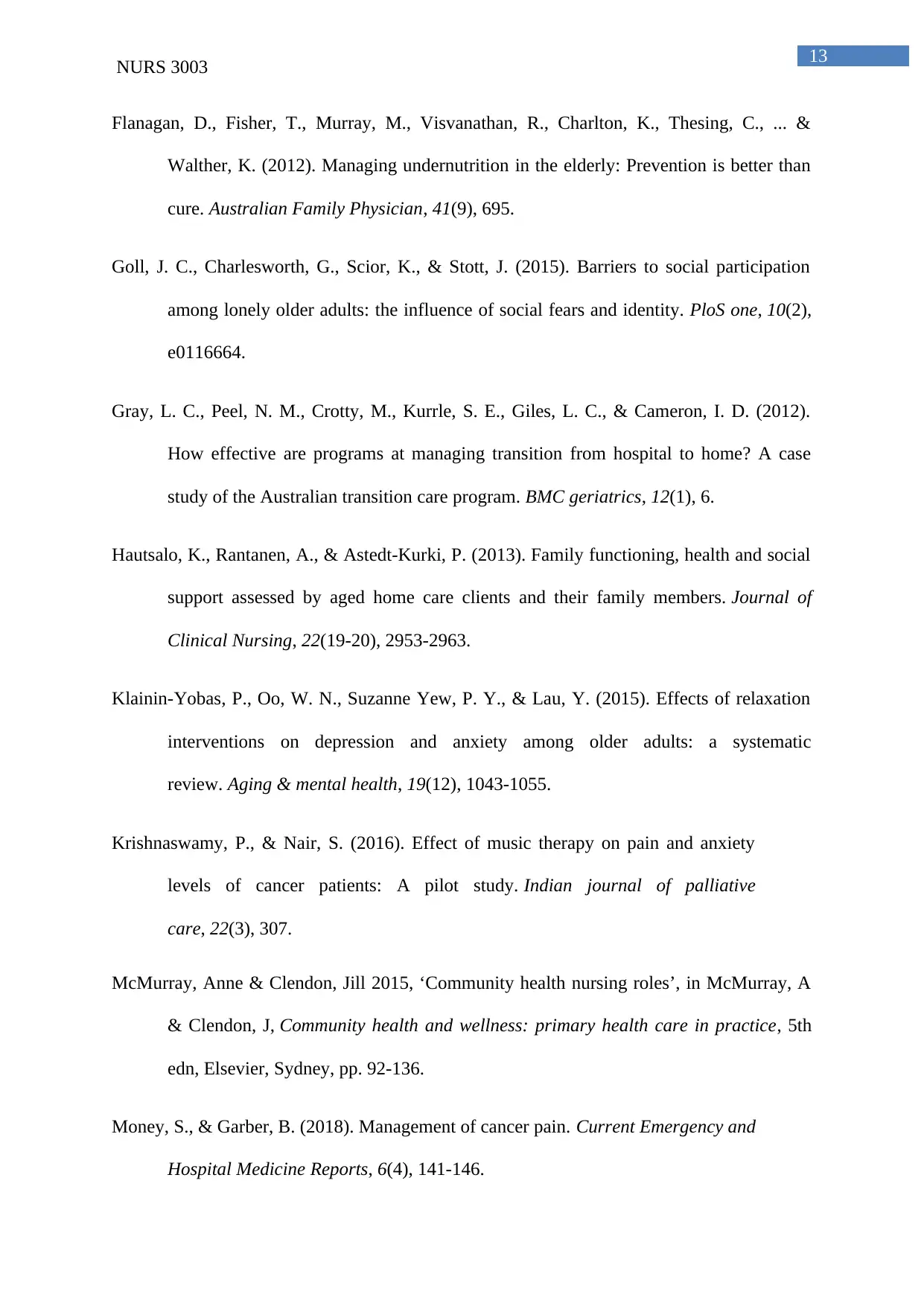
13
NURS 3003
Flanagan, D., Fisher, T., Murray, M., Visvanathan, R., Charlton, K., Thesing, C., ... &
Walther, K. (2012). Managing undernutrition in the elderly: Prevention is better than
cure. Australian Family Physician, 41(9), 695.
Goll, J. C., Charlesworth, G., Scior, K., & Stott, J. (2015). Barriers to social participation
among lonely older adults: the influence of social fears and identity. PloS one, 10(2),
e0116664.
Gray, L. C., Peel, N. M., Crotty, M., Kurrle, S. E., Giles, L. C., & Cameron, I. D. (2012).
How effective are programs at managing transition from hospital to home? A case
study of the Australian transition care program. BMC geriatrics, 12(1), 6.
Hautsalo, K., Rantanen, A., & Astedt‐Kurki, P. (2013). Family functioning, health and social
support assessed by aged home care clients and their family members. Journal of
Clinical Nursing, 22(19-20), 2953-2963.
Klainin-Yobas, P., Oo, W. N., Suzanne Yew, P. Y., & Lau, Y. (2015). Effects of relaxation
interventions on depression and anxiety among older adults: a systematic
review. Aging & mental health, 19(12), 1043-1055.
Krishnaswamy, P., & Nair, S. (2016). Effect of music therapy on pain and anxiety
levels of cancer patients: A pilot study. Indian journal of palliative
care, 22(3), 307.
McMurray, Anne & Clendon, Jill 2015, ‘Community health nursing roles’, in McMurray, A
& Clendon, J, Community health and wellness: primary health care in practice, 5th
edn, Elsevier, Sydney, pp. 92-136.
Money, S., & Garber, B. (2018). Management of cancer pain. Current Emergency and
Hospital Medicine Reports, 6(4), 141-146.
NURS 3003
Flanagan, D., Fisher, T., Murray, M., Visvanathan, R., Charlton, K., Thesing, C., ... &
Walther, K. (2012). Managing undernutrition in the elderly: Prevention is better than
cure. Australian Family Physician, 41(9), 695.
Goll, J. C., Charlesworth, G., Scior, K., & Stott, J. (2015). Barriers to social participation
among lonely older adults: the influence of social fears and identity. PloS one, 10(2),
e0116664.
Gray, L. C., Peel, N. M., Crotty, M., Kurrle, S. E., Giles, L. C., & Cameron, I. D. (2012).
How effective are programs at managing transition from hospital to home? A case
study of the Australian transition care program. BMC geriatrics, 12(1), 6.
Hautsalo, K., Rantanen, A., & Astedt‐Kurki, P. (2013). Family functioning, health and social
support assessed by aged home care clients and their family members. Journal of
Clinical Nursing, 22(19-20), 2953-2963.
Klainin-Yobas, P., Oo, W. N., Suzanne Yew, P. Y., & Lau, Y. (2015). Effects of relaxation
interventions on depression and anxiety among older adults: a systematic
review. Aging & mental health, 19(12), 1043-1055.
Krishnaswamy, P., & Nair, S. (2016). Effect of music therapy on pain and anxiety
levels of cancer patients: A pilot study. Indian journal of palliative
care, 22(3), 307.
McMurray, Anne & Clendon, Jill 2015, ‘Community health nursing roles’, in McMurray, A
& Clendon, J, Community health and wellness: primary health care in practice, 5th
edn, Elsevier, Sydney, pp. 92-136.
Money, S., & Garber, B. (2018). Management of cancer pain. Current Emergency and
Hospital Medicine Reports, 6(4), 141-146.
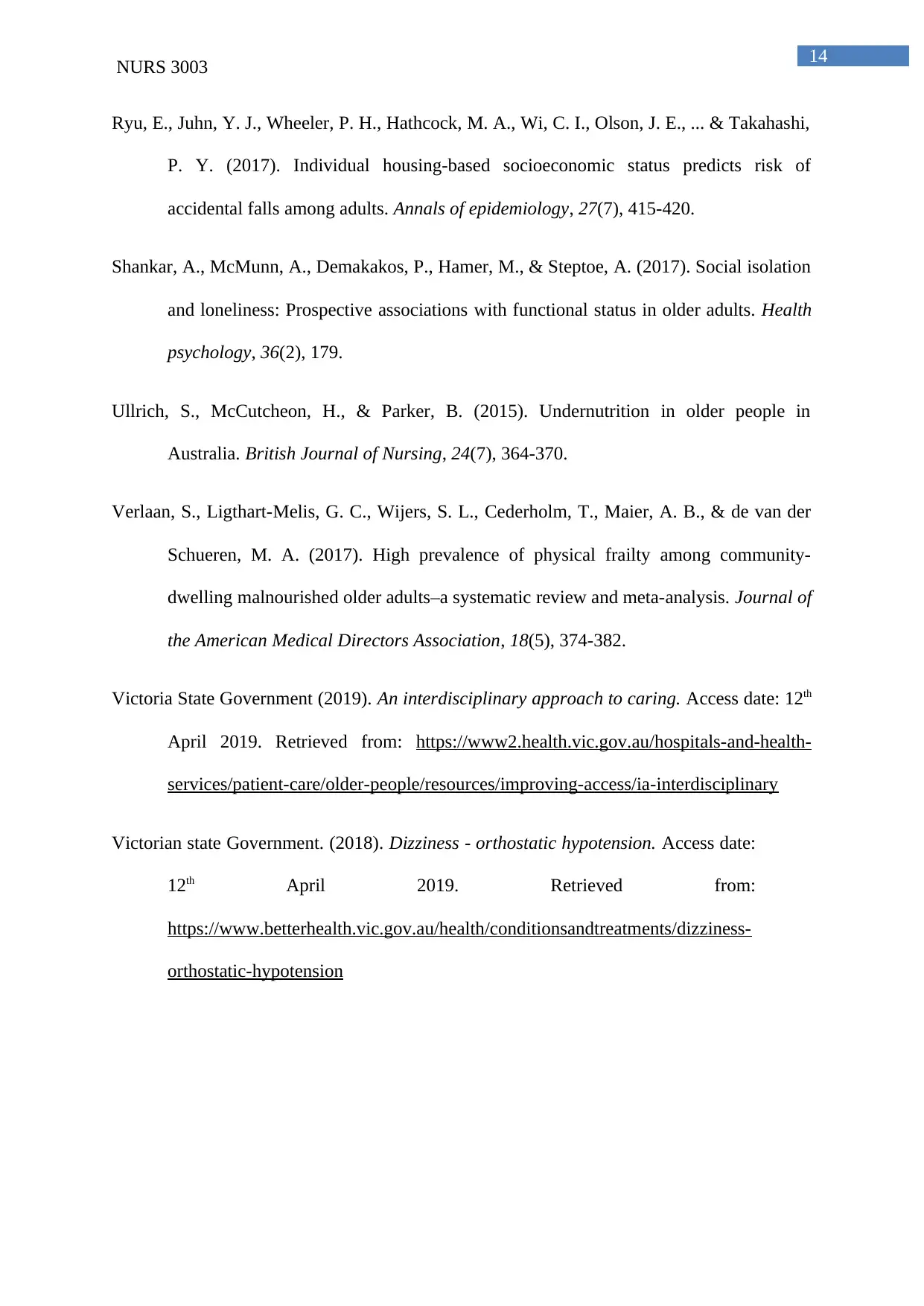
14
NURS 3003
Ryu, E., Juhn, Y. J., Wheeler, P. H., Hathcock, M. A., Wi, C. I., Olson, J. E., ... & Takahashi,
P. Y. (2017). Individual housing-based socioeconomic status predicts risk of
accidental falls among adults. Annals of epidemiology, 27(7), 415-420.
Shankar, A., McMunn, A., Demakakos, P., Hamer, M., & Steptoe, A. (2017). Social isolation
and loneliness: Prospective associations with functional status in older adults. Health
psychology, 36(2), 179.
Ullrich, S., McCutcheon, H., & Parker, B. (2015). Undernutrition in older people in
Australia. British Journal of Nursing, 24(7), 364-370.
Verlaan, S., Ligthart-Melis, G. C., Wijers, S. L., Cederholm, T., Maier, A. B., & de van der
Schueren, M. A. (2017). High prevalence of physical frailty among community-
dwelling malnourished older adults–a systematic review and meta-analysis. Journal of
the American Medical Directors Association, 18(5), 374-382.
Victoria State Government (2019). An interdisciplinary approach to caring. Access date: 12th
April 2019. Retrieved from: https://www2.health.vic.gov.au/hospitals-and-health-
services/patient-care/older-people/resources/improving-access/ia-interdisciplinary
Victorian state Government. (2018). Dizziness - orthostatic hypotension. Access date:
12th April 2019. Retrieved from:
https://www.betterhealth.vic.gov.au/health/conditionsandtreatments/dizziness-
orthostatic-hypotension
NURS 3003
Ryu, E., Juhn, Y. J., Wheeler, P. H., Hathcock, M. A., Wi, C. I., Olson, J. E., ... & Takahashi,
P. Y. (2017). Individual housing-based socioeconomic status predicts risk of
accidental falls among adults. Annals of epidemiology, 27(7), 415-420.
Shankar, A., McMunn, A., Demakakos, P., Hamer, M., & Steptoe, A. (2017). Social isolation
and loneliness: Prospective associations with functional status in older adults. Health
psychology, 36(2), 179.
Ullrich, S., McCutcheon, H., & Parker, B. (2015). Undernutrition in older people in
Australia. British Journal of Nursing, 24(7), 364-370.
Verlaan, S., Ligthart-Melis, G. C., Wijers, S. L., Cederholm, T., Maier, A. B., & de van der
Schueren, M. A. (2017). High prevalence of physical frailty among community-
dwelling malnourished older adults–a systematic review and meta-analysis. Journal of
the American Medical Directors Association, 18(5), 374-382.
Victoria State Government (2019). An interdisciplinary approach to caring. Access date: 12th
April 2019. Retrieved from: https://www2.health.vic.gov.au/hospitals-and-health-
services/patient-care/older-people/resources/improving-access/ia-interdisciplinary
Victorian state Government. (2018). Dizziness - orthostatic hypotension. Access date:
12th April 2019. Retrieved from:
https://www.betterhealth.vic.gov.au/health/conditionsandtreatments/dizziness-
orthostatic-hypotension

15
NURS 3003
NURS 3003
1 out of 16
Your All-in-One AI-Powered Toolkit for Academic Success.
+13062052269
info@desklib.com
Available 24*7 on WhatsApp / Email
![[object Object]](/_next/static/media/star-bottom.7253800d.svg)
Unlock your academic potential
© 2024 | Zucol Services PVT LTD | All rights reserved.

